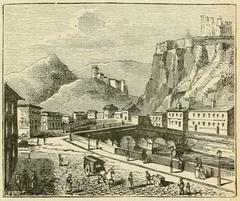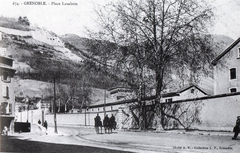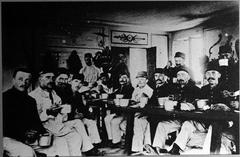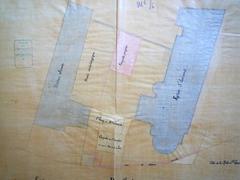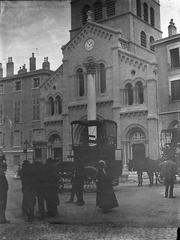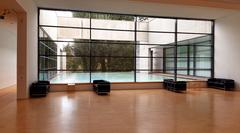
Collegiate Church of Saint-André Grenoble: Visiting Hours, Tickets, and Historical Guide
Date: 04/07/2025
Introduction
The Collegiate Church of Saint-André stands as one of Grenoble’s most significant historical and architectural landmarks. A masterpiece of Gothic architecture and a symbol of the city’s medieval past, it offers visitors a journey through centuries of religious, political, and artistic evolution. Whether you’re drawn by its soaring bell tower, intricate stained glass, or storied necropolis, Saint-André remains central to Grenoble’s identity and a must-see for travelers, historians, and architecture enthusiasts alike (Grenoble Tourisme, Grenoble Patrimoine, Religiana).
Table of Contents
- Early Foundations and Medieval Development
- Architectural Evolution and Features
- Role in Political and Religious History
- Artistic Highlights and Notable Tombs
- Conservation and Restoration
- Visiting Information: Hours, Tickets, and Accessibility
- Guided Tours and Special Events
- Tips and Nearby Attractions
- Frequently Asked Questions (FAQ)
- Conclusion
- References
Early Foundations and Medieval Development
Founded between 1228 and 1245 by André Dauphin de Bourgogne, the Collegiate Church of Saint-André was originally conceived as a private chapel and dynastic necropolis for the Dauphins of Viennois, the region’s ruling family. Its construction on the site of earlier religious buildings signaled the Dauphins’ political and spiritual authority, establishing a key center of power in the Dauphiné (Grenoble Tourisme). The church was served by a chapter of canons, shaping Grenoble’s religious and civic life.
Architectural Evolution and Features
Exterior Composition
The church is noted for its robust stone masonry, pointed Gothic arches, and a monumental bell tower, completed in 1331. At 56 meters, the bell tower was Grenoble’s tallest structure until the 20th century and is topped by a tuff-clad spire, as well as the city’s first public clock installed in 1398 (Religiana, grenoble-patrimoine.fr). The use of local materials anchors the church in its Alpine context.
Interior Layout
Inside, Saint-André features a traditional Latin cross plan with a nave, side aisles, transepts, and choir. Ribbed vaults and carved keystones create a harmonious, uplifting atmosphere. The interior’s unity and relative lack of later alterations make it a rare example of preserved medieval ecclesiastical architecture (France-Voyage).
Decorative Elements
Stained glass windows, periodically restored, illuminate the nave and choir with vibrant color. Carved tombs and heraldic motifs reference the Dauphin dynasty. The church also houses the tomb of Pierre Terrail de Bayard, the famous “chevalier sans peur et sans reproche” (knight without fear or reproach), which has been a place of pilgrimage since 1822 (Religiana).
Role in Political and Religious History
Saint-André’s proximity to the former Dauphin palace and Parliament made it central to Grenoble’s political and religious life. During the Wars of Religion, it served as a Catholic stronghold. After the French Revolution, while many ecclesiastical buildings were closed or repurposed, Saint-André was restored to religious use in the 19th century, adapting to societal changes and maintaining its role as a parish church (Grenoble Patrimoine).
The church’s chapter of canons played an active part in educational initiatives, collaborating with the Brothers of the Christian Schools in the 18th century under Canon Didier (dlsfootsteps.org). Saint John Baptist de La Salle, founder of the Institute of the Brothers of the Christian Schools, was known to attend Mass here with his students.
Artistic Highlights and Notable Tombs
Beyond its architectural unity, Saint-André contains significant works of art. Highlights include:
- Stained Glass: Restored windows illuminate the interior with colored light, often depicting local saints and historical figures.
- Bayard Tomb: Monument to Pierre Terrail de Bayard, symbolizing chivalric ideals (Religiana).
- Dynastic Necropolis: The crypt holds the tombs of the Dauphins, including Humbert II, the last Dauphin before the region’s annexation to France. Though many original tombs were destroyed during the Wars of Religion, the site still evokes the church’s dynastic legacy (Wikipedia).
Conservation and Restoration
Classified as a Monument Historique in 1908, Saint-André has benefited from ongoing restoration campaigns. Efforts have included structural stabilization, cleaning of the façade, stained glass restoration, and conservation of 17th-century painted decorations recently uncovered during maintenance (Ministère de la Culture, Religiana). These works ensure the church’s preservation for future generations.
Visiting Information: Hours, Tickets, and Accessibility
- Opening Hours: Typically open daily from 9:00 AM to 6:00 PM; hours may vary on holidays and for special events. Some sources note opening Tuesday to Sunday, 10:00 AM to 6:00 PM (grenoble-patrimoine.fr). Always check the official website before your visit.
- Tickets: General admission is free. Guided tours or special exhibitions may require advance booking and a fee.
- Accessibility: The main entrance and nave are wheelchair accessible; some historic areas may present challenges. Assistance is available on request.
- Photography: Permitted inside, but visitors should respect services and avoid using flash (France-Voyage).
Guided Tours and Special Events
- Guided Tours: Available regularly, especially on weekends at 11:00 AM and 3:00 PM. Booking ahead is recommended (Grenoble Tourisme).
- Special Events: Seasonal concerts and religious ceremonies are held throughout the year. Check the events calendar for up-to-date information.
Tips and Nearby Attractions
- Best Time to Visit: Morning or late afternoon for the best natural light through stained glass and fewer crowds.
- Nearby Sights: Former Parliament building, Grenoble Cathedral, the Bastille Cable Car, and Place Saint-André’s lively cafés.
- Transport: Easily accessible by public transport; parking is available nearby. The area is pedestrian-friendly (Monnuage).
- Photography: The bell tower and interior vaults are ideal photo subjects.
- Weather: The church provides a cool retreat in summer and shelter in winter (Wanderlog).
Frequently Asked Questions (FAQ)
Q: What are the visiting hours?
A: Generally open daily from 9:00 AM to 6:00 PM. Check for holiday schedules.
Q: Is admission free?
A: Yes, general entry is free. Guided tours may require a fee.
Q: Is the church accessible for people with disabilities?
A: Yes, main areas are wheelchair accessible; some historic sections may be less so.
Q: Are guided tours available?
A: Yes, on weekends and by arrangement through the tourism office.
Q: Is photography allowed?
A: Yes, but please be respectful during services and avoid flash.
Q: What other historical sites are nearby?
A: Grenoble Cathedral, Basilica of the Sacred Heart, and the Bastille Cable Car.
Conclusion
The Collegiate Church of Saint-André is not just a monument but a living testament to Grenoble’s layered past. Its Gothic architecture, dynastic tombs, and enduring role in civic and religious life make it an essential destination for anyone seeking to understand the city’s heritage. With free admission, central location, and an array of cultural events, Saint-André invites every visitor to experience the heart of Grenoble’s history.
Plan your visit today using official resources, and consider enhancing your experience by downloading the Audiala app for audio guides and updates on events. Share your journey and connect with fellow travelers by following Audiala on social media.
References
- Collegiate Church of Saint-André, Grenoble Tourisme, 2025
- Eglise Collégiale Saint-André, Grenoble Patrimoine, 2025
- Collegiate Church of Saint-André in Grenoble, Religiana, 2025
- Collegiate Church of Saint-André, France-Voyage, 2025
- Collégiale Saint-André, Grenoble Patrimoine, 2025
- Saint-André Church in Grenoble, Wikipedia, 2025
- Official Grenoble Tourism Website, 2025
- DLS Footsteps: Saint-André Church, 2025
- Wanderlog: Collégiale Saint-André, 2025
- Monnuage: Collégiale Saint-André
- Ministère de la Culture









